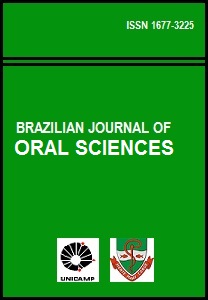Abstract
Analgesics are frequently used in dentistry for the management of dental pain. Dental clinicians should choose the medicine based on its mechanism of action and toxicity, to promote a successful analgesic effect as well as comfort to the patient. The purpose of this first article is to describe the pharmacological mechanisms of action of the three analgesics considered for the management of mild to moderate acute dental pain.References
Phero JC, Becker D. Rational use of analgesic combinations. Dent Clin North Am 2002; 46: 691-705 2. Ardekian L, Gaspar R, Peled M, Brener B, Laufer D. Does low-dose aspirin therapy complicate oral surgical procedures? J Am Dent Assoc 2000; 131: 331-5.
Moncada S, Ferreira SH, Vane JR. The blockade of the local generation of prostaglandins explains the analgesic action of aspirin. Pol J Pharmacol Pharm 1974; 26: 77-8.
Hersh EV, Moore PA, Ross GL. Over-the-counter analgesics and antipyretics: a critical assessment. Clin Ther 2000; 22: 500-18.
Haas, DA. An update on analgesics for the management of acute postoperative dental pain. J Can Dent Assoc 2002; 68: 476-82.
Andrade ED. Terapêutica medicamentosa em odontologia. São Paulo: Artes Médicas; 1998.
Foulke CN. Gingival hemorrhage related to aspirin ingestion. A case report. J Periodontol 1976; 47: 355-7.
Pawlak DF, Itkin AB, Lapeyrolerie FM, Zweig B. Clinical effects of aspirin and acetaminophen on hemostasis after exodontics. J Oral Surg 1978; 36: 944-7.
Sullivan-Bolyai JZ, Corey L. Epidemiology of Rey’s Syndrome. Epidemiol Rev 1981; 3: 1-26 10. Hurwitz ES. Rey’s Syndrome. Epidemiol Rev 1989; 11: 249- 53.
Botting RM. Mechanism of action of Acetaminphen: Is there a cyclooxygenase 3? Clin Infect Dis 2000; 31 Suppl 5: S202-10.
Flower RJ, Moncada S, Vane JR. Analgesic-antipyretics and anti-inflammatory agents; drugs employed in the treatment of gout. In: Gilman AG, Goodman LS, Gilman A. The Pharmacologic Basis of Therapeutics. 7thed. Elmsford: Pergamon Press; 1985. p.692-5.
Björkman R, Hallman KM, Hedner J, Hedner T, Henning M. Acetaminophen blocks spinal hyperalgesia induced by NMDA and substance P. Pain 1994; 57: 259-64.
Flower RJ, Vane JR. Inhibition of prostaglandin synthetase in brain explains the anti-pyretic activity of paracetamol (4- acetamidophenol). Nature 1974; 15: 410-1.
Vane JR. The fight against rheumatism: from willow bark to COX-1 sparing drugs.J Physiol Pharmacol 2000; 51: 573-86.
Mitchell JA, Akarasereenont P, Thiemermann C, Flower RJ, Vane JR. Selectivity of nonsteroidal anti-inflammatory drugs as inhibitors of constitutive and inducible cyclooxygenase. Proc Natl Acad Sci 1993; 90: 1693-7.
Chandrasekharan NV, Dai H, Roos LT, Evanson NK, Tomsik J, Elton TS et al.COX-3, a cyclooxygenase-1 variant inhibited by acethaminophen and other analgesic/antipyretic drugs: cloning, structure and expression. Proc Natl Acad Sci USA 2002; 99: 13926-31.
Gordon SM, Brahim JS, Rowan J, Kent A, Dionne RA. Peripheral prostanoid levels and nonsteroidal antiinflammatory drug analgesia: replicate clinical trials in a tissue injury model. Clin Pharmacol Ther 2002; 72: 175-83.
Warner TD, Mitchell JA Cyclooxygenase-3 (COX-3): filling in the gaps toward a COX continuum? Proc Natl Acad Sci USA 2002; 15: 13371-3.
Simmons DL, Botting RM, Robertson PM, Madsen ML, Vane JR. Induction of an acetaminophen-sensitive cyclooxygenase with reduced sensitivity to nonsteroid antiinflamatory drugs. Proc Natl Acad Sci USA 1999; 96: 3275-80.
Cooper AS, Desjardins PJ. Peripheral acting (nonopioid) analgesics. In: Neidle EA, Yagiela JÁ. Pharmacology and therapeutics for dentistry. 3rded. Saint Louis: Mosby; 1989. p.293-307.
Gladtke E. Use of antipyretic analgesics in the pediatric patient. Am J Med 1983; 75: 121-6.
Lynn B. Effect of neonatal treatment with capsaicin on the numbers and properties of cutaneous afferent units from the hairy skin of the rat. Brain Res 1984; 322: 255-60.
Ferreira SH, Lorenzetti BB, De Campos DI. Induction, blockade and restoration of a persistent hypersensitive state. Pain 1990; 42: 365-71.
Lorenzetti BB, Ferreira SH. Mode of analgesic action of dipyrone: direct antagonism of inflammatory hyperalgesia. Eur J Pharmacol 1985; 114: 375-81.
Jardim C, Lotufo PA, Maluf EP, Benseñor IM. Painkiller usage for headache in Brazil. Cephalalgia 2001; 21: 469.
Maia LC, Valença MGV. Estudo comparativo do efeito da dipirona, paracetamol e ácido acetilsalicílico sobre o sistema cardiovascular, alívio da dor e sangramento em cirurgias odontológicas eletivas. Um estudo “in vivo”. Âmbito Odontol 1994; 3: 10-16.
Andrade SE. Comparative safety evaluation of non-narcotic analgesics. J Clin Epidemiol. 1998; 51:1357-65.
International Agranulocytosis and Aplastic Anemia Study (The Boston Study) - Risks of agranulocytosis and aplastic anemia. A first report of their relation to drug use with reference to analgesics. J Am Med Assoc 1986; 256: 1749-57.
Agência Nacional de Vigilância Sanitária. Painel internacional de avaliação da segurança da dipirona; 2001 Jul 3-4. Brasília: ANVISA; 2001.
Holmes A, Davidson LE. Reye’s syndrome and analgesic choice in dentistry. Br Dent J 1989; 167: 345-6.
The Brazilian Journal of Oral Sciences uses the Creative Commons license (CC), thus preserving the integrity of the articles in an open access environment.

